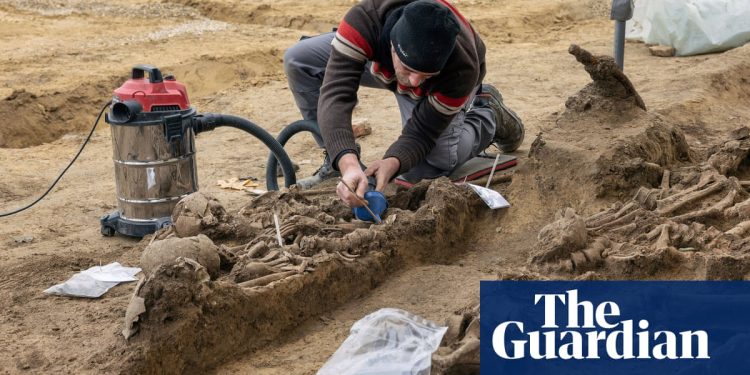While the construction teams turned dirt to renovate a football field in Vienna last October, they arrived on an unprecedented discovery: a bunch of skeletal remains intertwined in a serious mass dating from the Roman Empire of the first century, the bodies of warriors killed in a battle involving Germanic tribes.
This week, after the archaeological analysis, experts from the Vienna Museum made a first public presentation of the tomb – linked to “a catastrophic event in a military context” and evidence of the first known fights in this region.
The bodies of 129 people were confirmed on the site of the Vienna de Mijoter district. The excavation teams have also found many luxurized bones and think that the total number of bodies could exceed 150 – a discovery which, according to them, would be unprecedented in central Europe.
Michaela Binder, who directed the archaeological excavation, said: “In the context of the acts of Roman war, there are no comparable finds of combatants. There are huge battlefields in Germany where weapons have been found. But finding the dead, which is unique for the whole Roman history. ”
The soldiers of the Roman Empire were generally cremated until the third century.
The pit where the bodies were deposited suggest a hasty or disorganized spill of corpses. Each skeleton examined has shown signs of injury – head, torso and in particular basin.
Kristina Adler-Wölfl, head of the archaeological department of Vienna City, said: “They have different battle injuries, which excludes execution. It’s really a battlefield. There are sword injuries, spears; injuries of blunt trauma. “
The dead are all men. Most were 20 to 30 years old and generally showed signs of good dental health.
Carbon 14 analysis helped up the bones between 80 and AD130. This was overcome against the artifacts found in the grave – armor, headset cheese and nails cheese used in distinctive Roman military shoes called Caligae.
One of the greatest clues was the presence of a dagger of a type of use specifically between the middle of the first century and the beginning of the second.
After promoting the newsletter
So far, only one victim has been confirmed as a Roman legionnaire. Archaeologists hope that the analysis of the isotopes of DNA and strontium will help to identify the fighters more and of which they were the side.
Adler -Wölfl said: “The most likely theory right now is that this is linked to the Danube campaigns of the Emperor Domitian – this is 86 to 96 AD.”
Archaeologists said they had also found signs of founding the colony that would become Vienna.


